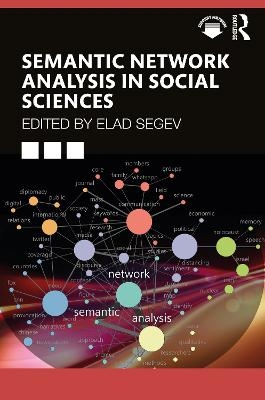
Semantic Network Analysis in Social Sciences
Routledge (Verlag)
978-0-367-63652-4 (ISBN)
Semantic Network Analysis in Social Sciences introduces the fundamentals of semantic network analysis and its applications in the social sciences. Readers learn how to easily transform any given text into a visual network of words co-occurring together, a process that allows mapping the main themes appearing in the text and revealing its main narratives and biases.
Semantic network analysis is particularly useful today with the increasing volumes of text-based information available. It is one of the developing, cutting-edge methods to organize, identify patterns and structures, and understand the meanings of our information society. The first chapters in this book offer step-by-step guidelines for conducting semantic network analysis, including choosing and preparing the text, selecting desired words, constructing the networks, and interpreting their meanings. Free software tools and code are also presented. The rest of the book displays state-of-the-art studies from around the world that apply this method to explore news, political speeches, social media content, and even to organize interview transcripts and literature reviews.
Aimed at scholars with no previous knowledge in the field, this book can be used as a main or a supplementary textbook for general courses on research methods or network analysis courses, as well as a starting point to conduct your own content analysis of large texts.
Elad Segev (PhD, Keele University) is Associate Professor at the Department of Communication, Tel Aviv University. He studies the relationship between information and power, focusing on global information flows, country image, international news, information search, and the digital divide. In his studies he employs text and network analysis techniques.
1. How to Conduct Semantic Network Analysis
Elad Segev
2. The News Coverage of Threats: Iranian Nuclear Programs in Israeli Press
Noa A. Hatzir, Elad Segev, Kohei Watanabe and Atsushi Tago
3. Provocation Narratives in Chinese and US Newspapers
Yuan Zhou, Sandrine Boudana and Elad Segev
4. Cable News Channels’ Partisan Ideology and Market Share Growth as Predictors of Social Distancing Sentiment during the COVID-19 Pandemic
James A. Danowski, Bei Yan and Ken Riopelle
5. Politicizing the Holocaust: A Comparative Analysis of Israeli and German Speeches
Maya Hadar, Regula Miesch and Elad Segev
6. Network of Ceavages? British Paradiplomacy in the (digital) International Discourse around Brexit
Jérôme Chariatte and Diana Ingenhoff
7. Sexual Assaults Blindsided by Politics on Twitter: Semantic Network Analysis of Symbolic #MeToo Cases in Japan and South Korea
Saki Mizoroki and Bumsoo Kim
8. Time to be Happy? WhatsApp and Phatic Communication within the Extended Family
Noa A. Hatzir
9. School Improvement: Semantic Network Analysis of the Literature
Audrey Addi-Raccah, Tali Shahrabani and Elad Segev
10. Identifying Patterns in Communication Science: Mapping Knowledge Structures using Semantic Network Analysis of Keywords
Nico Pfiffner
11. Summary and Concwlusion
Elad Segev
| Erscheinungsdatum | 01.12.2021 |
|---|---|
| Zusatzinfo | 16 Tables, black and white; 36 Halftones, black and white; 36 Illustrations, black and white |
| Verlagsort | London |
| Sprache | englisch |
| Maße | 156 x 234 mm |
| Gewicht | 460 g |
| Themenwelt | Sozialwissenschaften ► Soziologie ► Empirische Sozialforschung |
| ISBN-10 | 0-367-63652-2 / 0367636522 |
| ISBN-13 | 978-0-367-63652-4 / 9780367636524 |
| Zustand | Neuware |
| Haben Sie eine Frage zum Produkt? |
aus dem Bereich


